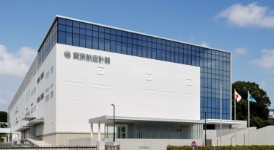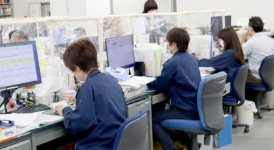Corporate History
Company Timeline
| 2022 | TKK receives the "Defense Structure Improvement Foundation Award" for development of the E/O Transceiver for the P-1 patrol aircraft. |
|---|---|
| 2022 | TKK transfers all stocks of its subsidiary TKK Works Co., Ltd. to KODEN Holdings Co., Ltd. |
| 2020 | Production of drones is started. Production of Digital Pressure Gauge DG-2000 series is started. |
| 2017 | A subsidiary TKK Works Co.,Ltd. is established. TKK becomes the first company in Japan to receive Level 5 Certification for a flight training device (Frasca Type 135.) |
| 2016 | TKK receives the "Japan Society for Aeronautical Engineering Incentive Award" for productivity improvement of diaphragms by replacing the electron beam welding machine. Maintenance and parts sales for UEDA TOKO products is discontinued. |
| 2014 | TKK becomes a subsidiary of KODEN Holdings Co., Ltd. Production of the LSM series vehicle speed measuring devices is started. TKK receives "Japan Society for Aeronautical Engineering Incentive Award" for productivity improvement by automatic simultaneous multiple correction data acquisition of micro Motion Sensor Unit. |
| 2013 | Production of motion and position measurement devices (Motion Sensor Unit) is started. |
| 2011 | TKK receives the "Defense Procurement Structure Improvement Foundation Award" for the development of the electronic display system for the T-5 primary trainer. Development of equipment for the modernized UH-60J search and rescue helicopter is started. TKK absorbs and merges its subsidiary TOKO ENGINEERING. |
| 2010 | TKK moves its headquarters and plant to Machida City, Tokyo. Production of equipment for the Type 10 tank is started. Production of Digital Pressure Gauge DG-950N is started. The Electronic ORBIS is remodeled. |
| 2009 | Production of Digital Pressure Gauge DG-980 is started. |
| 2008 | Production of equipment for Kawasaki P-1 patrol aircraft is started. |
| 2007 | Development of equipment for the middle range multi-purpose missile is started. Sales of semiconductor wafer visual inspection system 6313 is started. TKK absorbs and merges its subsidiary UEDA TOKO. |
| 2006 | Production of optical fiber gyros and other inertial devices is started. |
| 2005 | TKK receives accreditation for ISO 17025 for calibration services based on the National Measurement Standards Provision System of the Measurement Act. |
| 2004 | Development of control stick indicators for combat vehicles is started. Aerospace Division acquires JISQ9100 certification. |
| 2003 | Development of equipment for Lockheed C-130H transport aircraft is started. Sales of shipping containers for large ultra-precision optical lenses is started. Development of equipment for Mitsubishi F-4 support fighter is started. |
| 2001 | Development of equipment for Mitsubishi UH-1J multipurpose helicopter, Subaru OH-6 observation helicopter, and Kawasaki C-1 transport aircraft is started. |
| 2000 | Aerospace Division acquires JISQ9001 (ISO 9001) certification. Production of equipment for Mitsubishi SH-60K maritime patrol helicopter and Shinmaywa US-2 rescue aircraft is started. Production of ORBIS with vehicle type identification function is started. |
| 1999 | Production of semiconductor wafer overlay metorology system MAC-R is started. |
| 1996 | Production of equipment for Mitsubishi F-2 support fighter, UH-60JA multipurpose helicopter and Subaru OH-1 observation helicopter is started. |
| 1994 | Production of the Electronic ORBIS is started. |
| 1987 | Production of equipment for Mitsubishi SH-60J maritime patrol helicopter is started. |
| 1986 | Production of equipment for Kawasaki T-4 intermediate jet trainer and CH-47J transport helicopter is started. |
| 1983 | Komae headquarters and plant are completed. Production of equipment for Subaru AH-1S anti-tank helicopter is started. |
| 1982 | Production of semiconductor manufacturing/inspection equipment and image processing equipment is started. |
| 1980 | Haneda Maintenance Center Building is completed. Production of the LK-35 standby altimeter for Boeing 757 airliner is started. |
| 1979 | Nagoya Sales Office is established in Nagoya City. |
| 1978 | Production of equipment for Mitsubishi F-15J fighter and Kawasaki P-3C maritime patrol plane is started. |
| 1977 | A subsidiary UEDA TOKO Co. is established. |
| 1976 | TKK purchases a patent from the Boeing Company to begin manufacturing "ORBIS", an automated traffic enforcement device. |
| 1972 | TOKO ENGINEERING Co. is established. |
| 1967 | A subsidiary TOKO Co. is established. A U.S. subsidiary UNITED INSTRUMENTS,INC. is established in Wichita, Kansas. |
| 1958 |
|
| 1957 | TKK starts manufacturing various pressure gauges and other measuring instruments. |
| 1952 | TKK resumes manufacture and repair of aircraft equipment as soon as the ban is lifted. TKK begins production of facsimiles and develops the Toshafax, a mimeograph plate making machine. |
| 1948 |  The company emblem is redesigned, connecting the vertical line of “ト” and the axis of gyro. The company emblem is redesigned, connecting the vertical line of “ト” and the axis of gyro. In addition, the triangle wings of “Tombo Chocho” turn into fan shape to represent a shutter of the cinema projector – the new hot seller of the post-war era. |
| 1945 | After the end of the WWII, Japan's aviation industry is banned and TKK headquarters and plant in Kawasaki is seized by the Supreme Commander for the Allied Powers. TKK starts manufacturing various civilian products in Komae plant. |
| 1944 |  A new company emblem is created. The new design is a combination of our initial in Japanese character “ト” and a A new company emblem is created. The new design is a combination of our initial in Japanese character “ト” and a simplified silhouette of our then flagship product, gyro. To this day, it is affectionately called by employees as “Tombo Chocho”, meaning dragonfly and butterfly for its shape. |
| 1941 | Komae Plant is designated as a jointly controlled plant by the Imperial Army and Navy. TKK becomes Japan's largest manufacturer of aircraft instruments with 16,000 employees. |
| 1937 | The aviation instrument business of Tokyo Keiki Seisakusho Co. Ltd. is spun off, incorporated as Tokyo Aircraft Instrument Co. Ltd. (Tokyo Koku Keiki/TKK) in Kawasaki City with capital of 3 million yen, 400 employees. TKK begins production of directional gyro, horizontal indicators, turn and slip indicators, rate of climb indicators, magnetic compasses, autopilots, etc.  The company emblem at the time of foundation The company emblem at the time of foundation“TKK” stands for Tokyo Koku Keiki, which is our company name in Japanese; ”Koku” means aviation and “Keiki” means instrument. We are widely known as TKK in the industry. |

 The company emblem is redesigned, adding the Japanese company name abbreviation TKK.
The company emblem is redesigned, adding the Japanese company name abbreviation TKK. 

